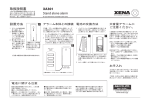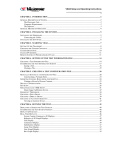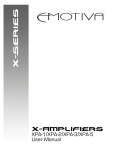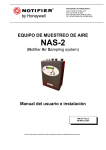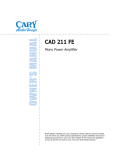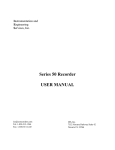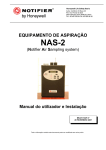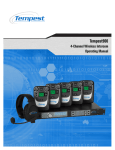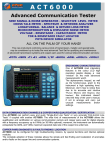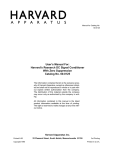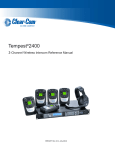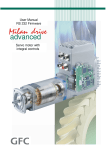Download Harvard Research Carrier Signal Conditioner User`s Manual
Transcript
The Harvard Research Carrier Signal Conditioner User’s Manual TABLE OF CONTENTS SECTION TITLE I GENERAL INFORMATION II III PAGE INTRODUCTION 1.1 SPECIFICATIONS 1.1 INSTALLATION 2.1 GENERAL 2.1 2.2 INITIAL INSPECTION 2.1 2.3 INSTALLATION 2.1 2.4 INPUT CONNECTIONS 2.1 2.5 POWER AND OUTPUT 2.2 2.6 PRELIMINARY SETUP 2.3 2.7 EXTENDING YOUR RANGE OF BALANCE 2.3 2.8 SIGNAL CABLE CONNECTIONS 2.3 2.9 PREAMPLIFIER POLARITY 2.4 2.10 THE LVDT 2.5 2.11 THE XX-XXXX ADAPTER ARM 2.5 2.12 OUTLINE DIMENSIONS 2.5 GENERAL 3.1 GENERAL 3.1 3.2 FRONT PANEL CONTROLS 3.1 3.3 INTERNAL CONTROLS 3.3 3.4 PLUG-IN COMPONENT TERMINALS 3.4 3.5 BRIDGE CALIBRATION 3.6 3.6 OPERATION 3.7 3.7 USING ZERO SUPPRESSION 3.7 3.8 OUTPUT – CHANNEL 2 3.7 3.9 FUNCTIONAL TEST PROCEDURE 3.8 LIST OF ILLUSTRATIONS FIGURE TITLE PAGE 1–1 XX-XXXX CARRIER AMPLIFIER 1.1 2–1 REAR VIEW 2.1 2–2 INPUT CONNECTOR PIN CONNECTIONS 2.2 2–3 CARD EDGE CONNECTIONS 2.2 2–4 TYPICAL SIGNAL CONNECTIONS 2.4 2–5 PREAMPLIFIER POLARITY 2.5 2–6 SENSITIVITY CONTROLS 2.6 2–7 TYPICAL LVDT SIGNAL CONNECTIONS 2.6 2–8 XX-XXXX ADAPTER 2.7 2–9 OUTLINE DIMENSIONS 2.7 3–1 FRONT PANEL CONTROLS 3.2 3–2 INTERNAL CONTROLS 3.5 3–3 TEST INPUT CIRCUIT 3.8 SECTION I GENERAL INFORMATION 1.1 Introduction The Harvard Research Carrier Signal Conditioner (Catalog No. 60--0110), is our latest answer to balancing, measuring and amplifying low level signals from carrier excited transducers such as strain gages, variable differential transformers or reluctance type transducers. The unit supplies an adjustable 1 to 10 volt RMS, 2.5 kHz signal for transducer excitation. Provision has been made internally for bridge completion resistors if one or two active bridge transducers are used. The main unit features are Automatic Phase Control and Automatic Zero Balance on comma. Remote Automatic Balance is available through the output connector. Another new feature is the Master/Slave Synchronization Switch. This is used when you are using more than one carrier amplifier. One amplifier is selected as the master, and the others as slave. This eliminates interaction between the oscillators in each of the carrier units. The amplifier has two outputs. Channel number one's output is 0 to 5 VDC with zero suppression and variable gain from 20 to 50,000. This channel is used primarily to furnish a signal to the (2000 series recorder ????). Channel number two provides a 0 to 10 volt output with a variable gain from 100 to 10,000. This output is set up for digital displays, etc. Both channels have direct and average filtering available with corner frequencies of 200 or 0.05 Hz with 12 db/octave roll-off. 1.2 Specifications Amplifier Input: Circuit Configuration Full floating and differential Input Impedance 1 M at 2.5 kHz floating and guarded Measurement Range ±100 μV to ±1 V RMS for full scale output at a calibration factor of 1 Input Attenuator Inaccuracy X1, X100 (internal switch ± 0.25% of full scale) Calibration Factor: Front panel (duodial) Range 0.5 to 10.5 Resolution ±0.05% of full scale Non-Linearity Auto Balance: ±0.25% of full scale Front panel switch, indicator Range 0 to ±10 mV RMS (R & C balance) Resolution 11 bit with 18 k R bal resistor Non-Linearity ±4 LSB out of 12 bit DAC Remote Command TTL compatible Common Mode Rejection > 120 dB at 60 Hz with 350 unbalance from input to chassis at 100 μV sensitivity Leakage Current < 10 μA RMS between any input terminal, including the excitation, and chassis with 120 V RMS 60 Hz applied per UL544 Maximum Safe Voltage, Common Mode: All 3000 and 5900 applications: No off ground voltage allowed IEC-601-1 applications in 2000 recorders: 150 VDC or peak AC from the input terminals to chassis IEC-348 applications in 2000 recorders: 500 VDC or peak AC from the input terminals to chassis Maximum Safe Voltage, Normal Mode: 50 VDC or peak AC between input terminals Terminals Provided for (internal) 3 bridge completion resistors, 1 cal resistor and 1 zero balance resistor Instability: Most sensitive scale (30 minute warm-up) Zero–Time: 0.05% of full scale/24 hrs Temperature 0.1% of full scale/°C Line 0.1% of full scale/10% line variation Gain-Time: 0.05% of reading/24 hrs Temperature 0.08% of full scale/°C Line 0.1% of full scale/10% line voltage change Channel 1 Output: Voltage: 0 to ±5 VDC into a 2 k load with 0.02 μfd capacitor or greater in parallel Impedance < 5 (short protected) Calibration Error ±0.1% of full scale Non-Linearity ±0.1% of full scale Noise With 350 input unbalance and direct filter < 10 μV peak-topeak Frequency Response: Direct DC to 200 Hz, 6 dB down at 200 Hz ±15% Average DC to 0.08 Hz, 6 dB down at 0.08 Hz ±20%; 12 dB/octave roll-off Attenuator: Steps OFF, 1000, 500, 250, 100, 50, 25, 10 Inaccuracy ±0.25% between steps Equivalent Input Signal Short, 10, 5, 2.5, 1, 0.5, 0.25 and 0.1 mV at a calibration factor of 1 Sensitivity: Range > 2.5 to 1 variation also detent X1 Maximum Linear Input Voltage 10 V RMS, sinusoidal at 2.5 kHz Zero Suppression: Range ±100 or ±1000 referred to the input Resolution ±0.05% full scale Non-Linearity ±0.25% full scale Calibration ±0.1% independent of transducer phase Channel 2 Output Voltage: 0 to ±10 VDC into a 2 k load with 0.02 μfd capacitor in parallel Impedance Same as channel 1 Calibration Error Same as channel 1 Non-Linearity ±0.1% of full scale, X1 gain Gain: Internal switch; X1 to X10 X1 position 1 mV RMS input = 1 VDC output X10 position 1 mV RMS input = 10 VDC output Noise Same as channel 1 Frequency Response Same as channel 1 Instability Same as channel 1 Direct-Average Filter Internal switch; switch is overridden to direct position when the front panel, Cal-Dir-Avg switch is placed in Cal position Transducer Excitation: Voltage Internally adjustable from 2 to 10 V RMS, maximum load 0.250 W Frequency 2500 Hz ±5% sine wave Total Harmonic Distortion < 0.25% at 5 V RMS amplitude Phase Demodulator Automatic in-phase with signal Synchronization Jumper selectable, master to 7 slaves Phase Reference 0° or 90°, internal switch selectable Normal-Reverse Internal switch selectable Amplitude Instability: With 30 minute warm-up Time ±0.02%/24 hrs Temperature ±0.1%/°C with 350 load Line ±0.01%/10% line voltage change Load Regulation 20% no load to full load with a 350 load Power Requirements +15 VDC at 125 mA -15 VDC at 125 mA 13 VAC at 60 Hz at 200 mA Accessories 11-5407-50 Mating Connector 11-5407-35 Transducer Adapter (Validyne, LVDT) 696238 Starter Kit 887291 Board Asm. Extender R1-288308-13500 Resistor 242878-121 Resistor (Bridge) 242878-351 Resistor (Bridge) 25-265969-15001 Resistor (Balance) 25-265969-50001 Resistor (Balance) SECTION II INSTALLATION 2.1 General This section describes the checks and inspections that should be made upon receiving Harvard's 60-0110 Research Carrier Signal Conditioner. It covers installation, signal input connections, and outline dimensions. 2.2 Initial Inspection Prior to attempting any electrical connections or operation visually examine the unit for broken or loose knobs, dented or nicked panels and broken or chipped rear connectors. 2.3 Installation The 60-0110 Research Carrier Signal Conditioner may be mounted directly in Harvard's Pressurized Ink and Thermal Pen Recorders, or Harvard's 8-, 4-, and 2-Channel Research Signal Conditioner Cases for use with other recorders. 2.3.1 Insertion (Paragraph 2.6 Preliminary Set-Up must be completed before insertion) To install the Signal Conditioner into the appropriate slot: a. Slide the Signal Conditioner into the enclosure until the rear output card edge connector is engaged. See Figure 2-1 REAR VIEW b. Tighten the rear retaining screw until the Signal Conditioner front panel is flush with the edge of the enclosure. Do Not Overtighten. This locks the Signal Conditioner into the enclosure. c. Connect the input signal connector and secure it by grasping the rear of the connector and pushing it onto the female connector after vertical alignment of the blue index mark. When a click is heard or an orange ring appears, the connector is locked in place. 2.3.2 Removal a. Disconnect the input connections with a counterclockwise turn to the connector and pull. b. Loosen the rear retaining screw. The Signal Conditioner will move forward abut 1/8 of an inch. c. 2.4 Carefully slide the entire Signal Conditioner out of the recorder or signal conditioner case. Input Connections Figure 2-2 shows the pin connections located at the rear of the Carrier Signal Conditioner. For the convenience of the user, a mating guarded, 12-pin Deutsch Input Connector is supplied (Catalog No. 60-0109). See Paragraph 2.8 for a typical wiring diagram. PIN FUNCTION 11 Signal (+) 12 Signal (-) 8 Excitation (-) 9 Excitation (+) 7 Shunt Cal. 10 2.5 Isolated Common Power and Output Output and power connections are made through a 16-pin card-edge connector. Refer to Figure 2-3 for wired connections. These connections to the recorder are already made, inside the system. PIN FUNCTION 1 * Common 2 Channel 1 Recorder Out 3 (-) 15 Volts 4 (+) 15 Volts 5 * Signal Common 6 Master/Slave Sync. 7 * Common 13 Volts AC 8 13 Volts AC A N.C. B Channel 1 Output C Remote auto-Balance Signal D N.C. E N.C. F N.C. H N.C. J Channel 2 Output * Commons are tied on board to chassis ground. 2.5.1 Multi-Carrier Operation Operating more than one Carrier in a system may require a synchronizing lead. That is, pin 6 of all the carrier channels are wired together. One Carrier Signal Conditioner is selected as master and the masterslave jumper is left at E4-E5 (see Figure 3-2). All other amplifiers are considered slaves, and the jumper is moved to E5-E6. 2.6 Preliminary Set-Up 2.6.1 – External Control Adjustment Adjust the external controls to the following settings: Control Full Scale Cal-Dir-Avg Setting OFF Dir Bal-ON-OFF ON Zero Suppression OFF Calibrate Sensitivity 4 At detent (X1) 2.6.2 – Internal Control Adjustment (Reference Sections 3.3 and 3.4) Remove right hand cover. Check for jumpers at E1-E2 and E4-E5. Adjust the controls as follows: Switch Position S1 (X100-X1) X1 S2A (X1-x10) X10 S2b (D-A) D S-3A (N-R) N S-3B (0-90) 0 2.6.3 – To Complete the Set-Up Assuming your transducer is a 4 active element type, follow this set-up to completion. If your si a 1 or 2 active element type, add bridge completion resistors. Install the Carrier Signal Conditioner in the proper channel. Plug in the cable from the transducer you are going to use. Make sure the transducer is in an at rest position (no load). The excitation is set at the factor at 5 V RMS, with a load (see Section 5, Calibration). If necessary, the excitation voltage can be set between 2 and 10 V RMS by adjusting R-16 and monitoring TP-10 and 11. Turn power on to the recorder and the Signal Conditioner. Allow for a 15 minute warm up period. Adjust the pen position to the center of the channel. Turn the F.S. control to 1000. Switch the Bal-ON-OFF switch to Bal. Hold momentarily. The Phase light and then the Bal. light will glow and the pen will return to the chart center. Your system is now balanced. If your system is unable to be balanced and oscillation will occur. The pen will swing to the edge of the chart and then back towards the middle slowly (about 2 cps) but will not go to the center. If this indication occurs, see Note below. NOTE: Your system will allow you to balance a 40 mV input (error) signal. This figure is arrived at by multiplying the amplifier gain at 10 mV (with 18 k “R” Balance Resistor) and the Calibrate setting of (4). If lower sensitivities are required, a higher number can be adjusted on the Calibrate control, and/or X100X1 switch can be moved. Your total range of operation is from 10 mV to 10 V. You can now change the FS attenuator to your desired sensitivity. Also the calibrate control for proper amplification. 2.7 Extending Your Range of Balance This Signal Conditioner has a gain of about 2.5 to 25 controlled by the front panel calibration control. Figure 2-6 shows the controls used to change the sensitivity. 2.7.1 The Signal Conditioner, as stated, has an allowable 10 mV input signal range because of the 18 k resistor in the R Balance position. If it is necessary to increase the sensitivity to 1 mV we install a 1.3 k resistor, call for details. The formula for computing the R balance resistor is: 45.54 e(in) Rbal = 0.035-e(in) Where R bal is in k and e(in) is in volts. E(in) is the desired balance range and should be limited to < 0.025 V. You should remember that the higher the R balance resistance, the more coarse the balance will be. 2.8 Signal Cable Connections Use a four conductor, double foil, shielded signal cable Belden No. 8434, or equivalent. The cable run from the transducer to Signal Conditioner should be one continuous length. No Splices are Permitted, but mating low level signal connectors may be used if necessary. Connect the double shielded signal cable pair to the Signal Conditioner signal input connector, pins 11 and 12. Connect the shielded signal cable pair to the transducer excitation pins 8 and 9 as shown in Figure 2-4. Some bridges include a “shunt resistor” for use in calibration. If so, it should be connected to pin 7 and a jumper must be placed in “Cal R” spot (see Figure 3-2). If Not, Pin 7 Must Be jumpered to Pin 9 in the Input Connector. (Internal “Cal R“ will be installed in Paragraph 3.5.) Connect the signal cable shield to pin 10 located in the input connector and ground the signal cable shield at the transducer as shown in Figure 2-4. Note: The transducer enclosure should be grounded at the transducer. It is important that the signal cable shield be insulated from the metal shell of the preamplifier input connector. If this is not done “ground loop” noise will be created by circulating currents in the signal cable shield between the transducer ground and the preamplifier chassis ground. 2.9 Preamplifier Polarity 1. When a POSITIVE signal is applied to a transducer we would expect the pen on the recorder chart to move from chart center to the LEFT. To accomplish this, the transducer is connected as shown in Figure 2-4. 2. Examination of Figure 2-5 will reveal that there is a polarity reversal between the preamplifier input and output. This is done to compensate polarity reversal that occurs in Harvard pendrive amplifiers. 3. for the POLARITY REVERSAL is accomplished by simply switching the internal switch, (N-R) from Normal to Reverse. This switch inverts the oscillator output. 2.10 The LVDT a. A typical connection of an LVDT to the carrier preamplifier can be seen in Figure 2-7. The center coil is the driven coil and obtains its signal from the excitation output pins 8 and 9. The two pick-up coils are hooked in series and sent to the input amplifier via input pins 11 and 12. b. The only change in set-up procedure, paragraph 2.6b, is the X100-X1 switch is placed in the X100 position. The reason is, most LVDT’s have very high output, usually in the volts range. 2.11 The 11-5407-35 Adapter Assembly This Adapter, Figure 2-8, was designed to mate Validyne type transducers with the 134615-35 Carrier Amplifier. It will also reduce the carrier input signal by a factor of approximately 20 to 1 to accommodate the relatively high Validyne transducer outputs. 2.12 Outline Dimensions Preamplifier outline dimensions are shown in Figure 2-9. SECTION III OPERATION 3.1 General This section describes and illustrates the controls of Carrier Amplifier models 13-4615-35. 13-G4615-35, and 20-4615-35, and provides complete operating instructions. 3.2 Front Panel Controls Item numbers listed below refer to circled numbers in Figure 3-1. ITEM CONTROL DESCRIPTION 1 Full Scale Attenuator (Channel 1) (S-101) 10 to 1000. Sets the Full Scale output of the amplifier in 7 steps from 2 Cal-Dir-Avg (S-102) Direct for normal operation. Average for normal operation. Calibrate to obtain a deflection change. without a mechanical load 3 Bal-ON-OFF (S-103) sets and locks the balance signal. BAL – A momentary toggle; it brings the balance and error ON – for normal operation; it signals together. signal from the amplifier. Allows OFF – removes only the balance checking Phase Lock. 4 Zero Suppression (Channel 1) +/-X100 switch (S-104) ±10 x 100 (1000% suppression) A 5 position switch: OFF, ±1 x 100 (100% suppression) and 5 Vernier (R-102) can be locked in any position. major divisions. For use with A ten-turn adjustable control that The dial is graduated into 10 item 4. 6 Calibrate (Channels 1 and 2) (R-103) Set .5 to 10.5). A 10-turn vernier resistor that sets the overall gain (Gage factor 7 Sensitivity (Channel 1) (R-104) Provides a 25:1 Signal Change A lockable variable resistor that sets the gain of Channel 1 only. from X1. 8 Trim Calibrate Resistor (R-101) amount of correction can be switch. This resistor is placed in series with ”Cal R” so that a small adjusted when using the Cal. 9 Bal Indicator (DS-102) balancing of the amplifier. When Green light is ON during the ”Bal” switch is activated. 10 Phase Indicator (DS-101) excitation to signal phase shift function of the internal switch Yellow light goes on when the exceeds ± 45° or ±90° as a S3B. 3.3 Internal Controls Item number listed below refer to those in Figure 3-2. ITEM CONTROL DESCRIPTION R-5 Gain Control Channel 2 Channel 2. Adjustment to set the gain of R-6 Zero Control Channel 1 Zero adjustment for Channel 1. R-7 Phase Zero amplifier. Zero adjustment for the Phase R-8 X10 Zero Suppression X10 suppression circuit. Calibration adjustment for the R-9 X1 Zero Suppression suppression circuit. Calibration adjustment for the X1 R-10 Negative Zero Suppression adjusted the negative component Once the positive suppression is is brought in with this R-11 Quad Zero adjustment. Quadrature amplifier zero R-13 Phase Balance amplifier. Balance control of the phase R-14 Quad Balance amplifier. Balance control of the quadrature R-15 Slave Phase amplifier. Used to produce Phase control of the Slave 2.5KHz signal for the bridge. R-16 Excitation Span oscillator. Adjusts the output of the R-17 Slave Balance of the power supply for U-1 Balances the ripple component against the oscillator output the transducer. R-82 Slave Zero zero. Balances U42 Slave Amplifier to R-84 Input X100 CMR position. CMR adjustment in the X 100 R-85 Input X100 Gain amplifier in the X100 position. Gain adjustment of the input R-88 Input X1 CMR the first stage amplifier in the X1 CMR adjustment or balance of position. control. to R-89 Gain Control Channel 1 proper level. Sets the gain of Channel 1 to its S-1 Input Attenuator X1-X100 by 100 so instead of 10 to 1000 FS This switch multiplies the input we would have 1000 to Channel 2 Gain X1-X10 only by a factor of 10. This switch multiplies Channel 2 100K. S-2A 3.3 Internal Controls (continued) ITEM CONTROL DESCRIPTION S-2B Channel 2 Dir-Avg. Filter Channel 2 in Dir or Avg mode Channel 2 goes to Dir regardless By this switch you can operate independent of Channel 1. when the Cal-Dir-Avg is to Cal. S-3A Excitation Norm-Rev. Phase switch reverses the phase of the Just as the name implies, this oscillator. S-3B Excitation 0 Degree – 90 Degree Phase be 0 Degrees with resistive Normal operation would type Transducers. other configurations a necessary and switched For Phase shift may be is available. 3.4 Plug-In Component Terminals Item numbers listed below refer to those on Figure 3-2. ITEM DESCRIPTION R1-R2-R3 Bridge completion. Cal R. (R-4) Bridge Shunt Calibration. Jumper E1-E2 Normal Calibration polarity reversal. Jumper E2-E3 Reverse (Reverses calibration only). Jumper E4-E5 Master be master, all others should be Synchronization: One unit must slave. Jumper E5-E6 Slave +/-10mV offset (18Kohms). Balance Resistor normally set for 3.4.1 Optional Filtering For noisy environments a means of changing the filter frequency of 200 Hz. (6 Db. down at 200 Hz. ± 15%) is provided. Both C-10 and C-11 must be changed. Use Figure 3-2 to determine their location. For Frequencies other than 200 Hz., C-10 and C-11 values may be calculated using the following formula: 3.5 Bridge Calibration After completing installation and setup instructions in Section 11, the unit may now be calibrated. Three methods of calibration are used and are described below: 1. Known calibration resistance (a given resistance equals a given mount of micro-inches per inch, lbs/sq. inch, etc.). 2. Transducer loading. 3. Calculating calibration resistance. mmHg, All three methods will be described in detail. User must determine most convenient method. Note: If your bridge includes a “Shunt R” for calibration, just place a jumper in the “Cal R” spot in the following steps. 1. Known Calibration Resistance a) Install transducer. b) If calibration resistance is known, simply insert correct calibration resistor where marked “CAL R”, and, if necessary, adjust the front panel trim control for exact resistance reading. (Internal Cal Resistor and the front panel trim control are additive. Part 3 below tells how to measure.) c) Turn “Full Scale” switch to 1000 and switch the “Bal-On-Off” switch to “Bal” momentarily. This balances the Bridge. d) With resistance controls properly set, push “Cal-Dir-Avg” switch to “Cal” position. e) Advance “Full Scale” control clockwise until desired Full Scale setting is reached. f) Now adjust “Calibrate” control to place pen on desired chart division. g) Return “Cal” switch to “Dir”. Example: For given transducer, 430K ohms equal 50mmHg. Install transducer and 430 K ohm R CAL resistor. Turn the “Full Scale” switch to 1000 and switch the “Bal-On-Off” switch to “Bal” momentarily. This balances the bridge. Turn “Cal-Dir-Avg”switch to “Cal” position. Advance “Full Scale” to 100 position. Adjust “Calibrate” control to 50% F.S. (25 divisions). Return toggle switch to“Dir” position. Each division on recorder chart now represents 2mmHg. 2. Transducer Loading a) If calibration resistance is unknown, it will be necessary to establish a known load or deflection at the transducer. Balance transducer per Section 2.6 and apply a known load. b) Advance “Full Scale” to desired full scale setting. c) Now adjust “Calibrate” control to place pen on desired chart division and lock control. d) Establish no-load condition at transducer. e) Set toggle switch to “Cal” position. f) Adjust internal CAL R and front panel “Trim” control until same pen deflection is achieved. g) Record dial setting versus load or deflection and transducer number for future calibration reference. Also note total resistance. (Cal R and “Trim” are in series in the “Cal” position. Part 3 below tells how to measure.) Example: For a typical transducer, apply a pressure of 100mmhg. Rotate “Full Scale” to 250 position. Adjust “Calibrate” control to set pen to 40% F.S. (20 division – 2VDC output). Each chart division now represents 5mmHg. Vent transducer to air and push toggle switch to “Cal” position. Adjust value of CAL R and front panel ”Trim” control until same output is achieved. Note total resistance. 3. Calculating Calibration Resistance The proper calibration resistance (Rcal) can also be calculated using the following equation: R= output resistance of transducer in ohms F= transducer calibration factor in microvolts (open circuit) per volt per cmHg. (excitation) Example: Determine the calibration resistance necessary to calibrate a Statham P23 DB for 10 cmHg when given. The calculated value is obtained by inserting a 1/4% resistor which is between the calculated value minus 5K ohms. The front panel “Trim” control is then adjusted until the desired resistance is achieved measuring across E1 and E3 with a precision ohmmeter. CAL R and the TRIM pot are in series and the TRIM pot has a max R of 10K ohms. 3.6 Operation Install the amplifier in its frame and properly lock it in place. Turn the power on for warm up, approximately 15 minutes. Connect the transducer to the input connector. Turn the “Full Scale” control to Off and the “Bal-On-Off” switch to Off. Calibrate control to 1.0 (unless otherwise determined). Sensitivity to X1-detent. Zero suppression Off. “Cal-Dir-Avg” to “Dir”. Turn on the chart drive and set pen position to chart center. Switch “Bal-On-Off” to On. Switch “Full Scale” to 1000. Now switch “Bal-On-Off” momentarily to “Bal”. When the green and yellow lights go off, your unit is in balance. You may advance the F.S. switch to a more appropriate sensitivity level. Your unit can now be “Cal”ed as in Par. 3.5 and you will then be ready for operating. 3.7 Using Zero Suppression Zero suppression permits the steady-state component of a complex signal (load) to be suppressed allowing the dynamic portion to be amplified and recorded in greater detail. a. Set up the bridge as described in paragraph 3.5. b. Turn Zero Suppression “Vernier” to 1.00 (1 turn CW from full counterclockwise position.) c. Apply a load to the strain gage and rotate the “Full Scale” control until the pen approaches chart edge. d. Set the “Zero Suppression” (item 4) control to the appropriate range and polarity. Pen should move back toward zero. e. Advance Zero Suppression “Vernier” dial clockwise until pen approaches chart zero. f. Advance “Full Scale” control clockwise until desired sensitivity is reached, keeping pen to chart zero with Xero Suppression “Vernier”. g. The load now may be varied around the static portion to obtain more information. useful 3.8 Output – Channel 2 Channel 2 was primarily designed to provide a signal for digital display and operates regardless of the position of the attenuator. Its full scale output is 0 to 10 VDC and is located at pin J on the XA-201 output strip. With the use of switch S-2A (internal) you can change the sensitivity of channel 2 by a factor of 10. With 1mVRMs input, the output will be 1 VDC in the x1 position, or 10 VDC in the x10 position. With switch S-2B you can change the output from direct (D) to average (A) DC display. 3.9 Functional Test Procedure This procedure should be performed to verify operation and calibration of the unit. If calibration is required, refer to Section V of this manual. 1. Connect two, 350 ohm resistors to the input connector as shown in Figure 3-3, below. Monitor channel 1 output (XA201-2) with a DMV. 2. Set the “Calibrate” control, R103, fully CW and the “Full Scale” switch, S101, to 1000. Set the “Sensitivity” control, R104, fully CW to the x1 position. 3. Set the “Zero Suppression” switch, S104, to +10 and adjust the Zero Suppression “Vernier”, R102, for a reading of .4.5 ±.001 VDC on the DVM and lock it. Turn the “Zero Suppression” switch, S104, through its various positions. The output on channel 1 should be shown below. Zero Suppression Switch Channel 1 Output (VDC) +10 +1 OFF -1 -10 4. -4.5 ± .001 -.45 ± .010 0 ± .010 +.45 ± .010 +4.5 ± .010 With the “Zero Suppression” switch, S104, set to -10, adjust the “Zero Suppression” control, R102, as shown below and read channel 1 output to check for linearity. Zero Suppression Switch Channel 1 Output (VDC) 10.00 8.00 6.00 4.00 2.00 0.00 +5.0 ± .0075 +4.0 ± .025 +3.0 ± .025 +2.0 ± .025 +1.0 ± .025 0.0 ± .025 5. Adjust the “Zero Suppression” control, R104, for a 2.5 ±.001 VDC reading on the DVM and then change the “Full Scale” switch, S101, to 500. The output on the DVM should change to 5.0 ±.02 VDC. 6. 7. Repeat Step 5 for the other “Full Scale” switch settings, adjusting the “Zero Suppression” switch and “Vernier” as shown below. The output should be 5.0 ±.02 VDC after switching to the next lower range. Full Scale Sw. (Before) 1000 500 250 100 50 25 Suppression Sw. Output Set (Before) Full Scale Sw. (After) -10 -10 -10 -1 -1 -1 2.5 ± .001 2.5 ± .001 2.0 ± .001 2.5 ± .001 2.5 ± .001 2.0 ± .001 500 250 100 50 25 10 Remove input network and DVM.

























